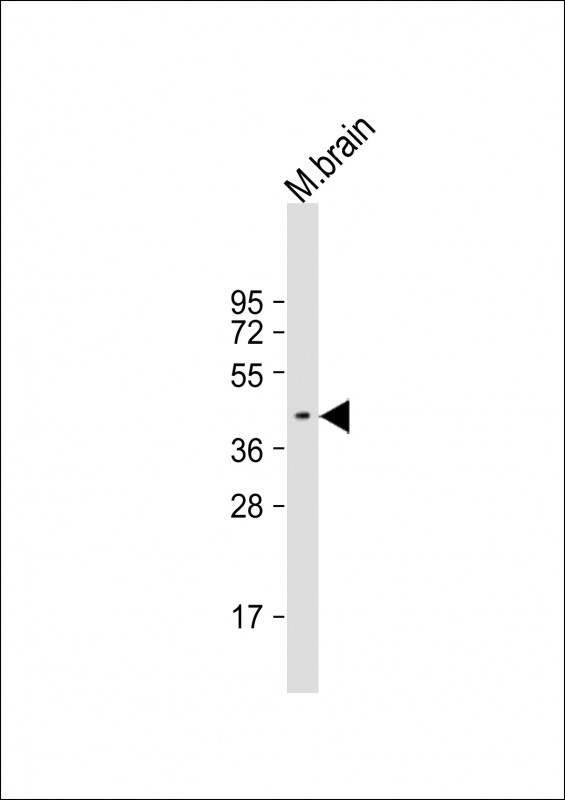

| WB | 1/1000 | Human,Mouse,Rat |
| IF | 咨询技术 | Human,Mouse,Rat |
| IHC | 咨询技术 | Human,Mouse,Rat |
| ICC | 技术咨询 | Human,Mouse,Rat |
| FCM | 咨询技术 | Human,Mouse,Rat |
| Elisa | 咨询技术 | Human,Mouse,Rat |
| Aliases | Transcription factor E2F3, E2F-3, E2F3, KIAA0075 |
| Entrez GeneID | 1871 |
| WB Predicted band size | 49.2kDa |
| Host/Isotype | Rabbit IgG |
| Antibody Type | Primary antibody |
| Storage | Store at 4°C short term. Aliquot and store at -20°C long term. Avoid freeze/thaw cycles. |
| Species Reactivity | Human, Mouse |
| Immunogen | This E2F3 antibody is generated from rabbits immunized with a KLH conjugated synthetic peptide between 151-180 amino acids from the Central region of human E2F3. |
| Formulation | Purified antibody in PBS with 0.05% sodium azide. |
+ +
以下是3-4条关于E2F3抗体的参考文献及其摘要概括:
---
1. **文献名称**:*"E2F3 regulates MYCN protein stability and co-represses MYCN-target genes in neuroblastoma"*
**作者**:Bradeen HA, et al.
**摘要**:该研究利用E2F3特异性抗体通过免疫共沉淀和Western blot分析,揭示了E2F3在神经母细胞瘤中通过调控MYCN蛋白稳定性影响肿瘤发展的机制,表明E2F3可作为潜在治疗靶点。
---
2. **文献名称**:*"E2F3 transcription factor is required for DNA synthesis in embryonic stem cells"*
**作者**:Wu L, et al.
**摘要**:通过敲除实验和E2F3抗体介导的染色质免疫沉淀(ChIP),研究发现E2F3在胚胎干细胞DNA复制中起关键作用,并调控多个细胞周期相关基因的表达。
---
3. **文献名称**:*"Amplification of E2F3 in human lung cancer and its association with clinical outcome"*
**作者**:Cooper CS, et al.
**摘要**:利用E2F3抗体进行免疫组化分析,发现肺癌组织中E2F3基因扩增与患者预后不良相关,提示其可作为肺癌诊断和预后的生物标志物。
---
4. **文献名称**:*"Distinct roles for E2F proteins in cell cycle control and apoptosis"*
**作者**:DeGregori J, et al.
**摘要**:通过E2F3抗体特异性抑制实验,研究揭示了E2F3与其他E2F家族成员(如E2F1)在细胞周期调控和凋亡中的功能差异,强调其在肿瘤发生中的独特作用。
---
以上文献涵盖了E2F3在肿瘤机制、细胞周期调控及抗体应用等方面的关键研究。
The E2F3 antibody is a crucial tool in studying the E2F3 transcription factor, a member of the E2F family that regulates cell cycle progression, DNA repair, and apoptosis. E2F3 exists in two isoforms, E2F3a and E2F3b, generated by alternative promoters. E2F3a promotes cell cycle entry by activating S-phase genes, while E2F3b may act as a transcriptional repressor. Dysregulation of E2F3 is implicated in cancers, as overexpression or amplification of E2F3 correlates with tumor proliferation, poor prognosis, and resistance to therapy in various malignancies, including ovarian, bladder, and lung cancers.
E2F3 antibodies are widely used in research to detect E2F3 protein expression, localization, and interactions via techniques like Western blotting (WB), immunohistochemistry (IHC), immunofluorescence (IF), and chromatin immunoprecipitation (ChIP). Specificity is critical due to structural similarities among E2F family members. Researchers validate these antibodies using knockout cell lines or siRNA-mediated knockdown to confirm target selectivity. Commercial E2F3 antibodies are often raised against unique epitopes within the N-terminal or DNA-binding domains of human E2F3. with host species (e.g., rabbit, mouse) and clonality (monoclonal/polyclonal) varying by application.
Studying E2F3 helps elucidate its role in Rb-E2F pathway dysregulation, oncogenesis, and potential therapeutic targeting. Antibodies also aid in assessing E2F3 as a biomarker for cancer diagnosis or treatment response.
×